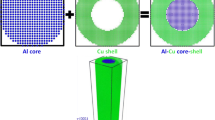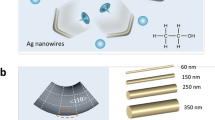Abstract
Room temperature (T room, 300 K) nanojoining of Ag has been widely employed in fabrication of microelectronic applications where the shapes and structures of microelectronic components must be maintained. In this research, the joining processes of pure Ag nanoparticles (NPs), Cu-Ag core-shell NPs, and nanowires (NWs) are studied using molecular dynamics simulations at T room. The evolution of densification, potential energy, and structural deformation during joining process are analyzed to identify joining mechanisms. Depending on geometry, different joining mechanisms including crystallization-amorphization, reorientation, Shockley partial dislocation are determined. A three-stage joining scenario is observed in both joining process of NPs and NWs. Besides, the Cu core does not participate in all joining processes, however, it enhances the mobility of Ag shell atoms, contributing to a higher densification and bonding strength at T room, compared with pure Ag nanomaterials. The tensile test shows that the nanojoint bears higher rupture strength than the core-shell NW itself. This study deepens understanding in the underlying joining mechanisms and thus nanojoint with desirable thermal, electrical, and mechanical properties could be potentially achieved.









Similar content being viewed by others
References
Ackland GJ, Jones AP (2006) Applications of local crystal structure measures in experiment and simulation. Phys Rev B 73(5):054104
Alarifi HA, Atis M, Özdoğan C, Hu A, Yavuz M, Zhou Y (2013a) Molecular dynamics simulation of sintering and surface premelting of silver nanoparticles. Mater Trans 54(6):884–889
Alarifi HA, Atis M, Özdoğan C, Hu A, Yavuz M, Zhou Y (2013b) Determination of complete melting and surface premelting points of silver nanoparticles by molecular dynamics simulation. J Phys Chem C 117(23):12289–12298
Asgari M, Behnejad H (2013) Molecular dynamics simulation of the melting process in Ag27Cu13 core–shell nanoalloy. Chem Phys 423:36–42
Bochicchio D, Ferrando R (2013) Morphological instability of core-shell metallic nanoparticles. Phys Rev B 87:165435
Calvo F (2013) Nanoalloys: from fundatmentals to emergent applications. Elsevier, Oxford
Chen C, Yan L, Kong ESW, Zhang Y (2006) Ultrasonic nanowelding of carbon nanotubes to metal electrodes. Nanotechnology 17(9):2192–2197
Cheng X, Zhang J, Zhang H, Zhao F (2013) Molecular dynamics simulations on the melting, crystallization, and energetic reaction behaviors of Al/Cu core-shell nanoparticles. J Appl Phys 114(8):084310
Cui Q, Gao F, Mukherjee S, Gu Z (2009) Joining and interconnect formation of nanowires and carbon nanotubes for nanoelectronics and nanosystems. Small 5(11):1246–1257
Delsante S, Borzone G, Novakovic R, Piazza D, Pigozzi G, Janczak-Rusch J, Pilloni M, Ennas G (2015) Synthesis and thermodynamics of Ag–Cu nanoparticles. Phys Chem Chem Phys 17:28387–28393
Fang ZZ, Wang H (2013) Densification and grain growth during sintering of nanosized particles. Int Mater Rev 53(6):326–352
Ferrando R (2015) Symmetry breaking and morphological instabilities in core-shell metallic nanoparticles. J Phys:Condens Matter 27(1):013003
Ferrando R (2016) Structure and properties of nanoalloys. Elsevier, Amsterdam
Gao F, Gu Z (2010) Nano-soldering of magnetically aligned three-dimensional nanowire networks. Nanotechnology 21(11):115604
Gao Y, Sun Y, Yang X, Sun Q, Zhao J (2015) Investigation on the mechanical behaviour of faceted Ag nanowires. Mol Simul 42(3):220–228
German RM (1996) Sintering theory and practice. Wiley-Interscience, New York
Hai HT, Ahn JG, Kim DJ, Lee JR, Chung HS, Kim CO (2006) Developing process for coating copper particles with silver by electroless plating method. Surf Coat Technol 201(6):3788–3792
Hu A, Guo JY, Alarifi H, Patane G, Zhou Y, Compagnini G, Xu CX (2010) Low temperature sintering of Ag nanoparticles for flexible electronics packaging. Appl Phys Lett 97(15):153117
Huang R, Wen YH, Shao GF, Sun SG (2013) Insight into the melting behavior of Au–Pt core–shell nanoparticles from atomistic simulations. J Phys Chem C 117(8):4278–4286
Huang R, Shao GF, Zeng XM, Wen YH (2014a) Diverse melting modes and structural collapse of hollow bimetallic core-shell nanoparticles: a perspective from molecular dynamics simulations. Sci Rep 4:7051
Huang R, Shao GF, Wen YH, Sun SG (2014b) Tunable thermodynamic stability of Au–CuPt core-shell trimetallic nanoparticles by controlling the alloy composition: insights from atomistic simulations. Phys Chem Chem Phys 16(41):22754–22761
Jiang S, Zhang Y, Gan Y, Chen Z, Peng H (2013) Molecular dynamics study of neck growth in laser sintering of hollow silver nanoparticles with different heating rates. J Phys D Appl Phys 46(33):335302
Kim D, Moon J (2005) Highly conductive ink jet printed films of nanosilver particles for printable electronics. Electrochem Solid-State Lett 8(11):J30–J33
Kim CK, Lee GJ, Lee MK, Rhee CK (2014) A novel method to prepare Cu@Ag core–shell nanoparticles for printed flexible electronics. Powder Technol 263:1–6
Kuntová Z, Rossi G, Ferrando R (2008) Melting of core-shell Ag-Ni and Ag-Co nanoclusters studied via molecular dynamics simulations. Phys Rev B 77:205431
Laasonen K, Panizon E, Bochicchio D, Ferrando R (2013) Competition between icosahedral motifs in AgCu, AgNi, and AgCo nanoalloys: a combined atomistic−DFT study. J Phys Chem C 117(49):26405–26413
Lechner W, Dellago C (2008) Accurate determination of crystal structures based on averaged local bond order parameters. J Chem Phys 129(11):114707
Lu P, Chandross M, Boyle TJ, Clark BG, Vianco P (2014) Equilibrium Cu-Ag nanoalloy structure formation revealed by in situ scanning transmission electron microscopy heating experiments. APL Mater 2:022107
Mariscal MM, Dassie SA, Levia EPM (2005) Collision as a way of forming bimetallic nanoclusters of various structures and chemical compositions. J Chem Phys 123:184505
Morones JR, Elechiguerra JL, Camacho A, Holt K, Kouri JB, Ramirez JT, Yacaman MJ (2005) The bactericidal effect of silver nanoparticles. Nanotechnology 16(10):2346–2353
Oderji HY, Behnejad H, Ferrando R, Ding H (2013) System-dependent melting behavior of icosahedral anti-Mackay nanoalloys. RSC Adv 3:21981–21993
Panizon E, Bochicchio D, Rossi G, Ferrando R (2014) Tuning the structure of nanoparticles by small concentrations of impurities. Chem Mater 26(11):3354–3356
Paz SA, Leiva EPM (2014) Unveiling the mechanism of core–shell formation by counting the relative occurrence of microstates. Chem Phys Lett 595-596:87–90
Peng P, Hu A, Zhou Y (2012) Laser sintering of silver nanoparticle thin films: microstructure and optical properties. Appl Phys A Mater Sci Process 108(3):685–691
Perelaer J, de Gans BJ, Schubert US (2006) Ink-jet printing and microwave sintering of conductive silver tracks. Adv Mater 18(16):2101–2104
Plimpton S (1995) Fast parallel algorithms for short-range molecular dyanmics. J Comput Phys 117(1):1–19
Qi Y, Cagin T, Kimura Y, Goddard WA III (1999) Molecular dynamics simulations of glass formation and crystallization in binary liquid metals Cu-Ag and Cu-Ni. Phys Rev B 59:3527
Ramachandramoorthy R, Gao W, Bernal R, Espinosa H (2016) High strain rate tensile testing of silver nanowires: rate-dependent brittle-to-ductile transition. Nano Lett 16(1):255–263
Rand BP, Peumans P, Forrest SR (2004) Long-range absorption enhancement in organic tandem thin-film solar cells containing silver nanoclusters. J Appl Phys 96(12):7519
Schiøtz J, Jacobsen KW (2003) A maximum in the strength of nanocrystalline copper. Science 301(5638):1357–1359
Schiøtz J, Di Tolla FD, Jacobsen KW (1998) Softening of nanocrystalline metals at very small grain sizes. Nature 391:561–563
Schiøtz J, Vegge T, Di Tolla FD, Jacobsen KW (1999) Atomic-scale simulations of the mechanical deformation of nanocrystalline metals. Phys Rev B 60:11971–11983
Shibuta Y, Suzuki T (2007) Melting and nucleation of iron nanoparticles: a molecular dynamics study. Chem Phys Lett 445(4–6):265–270
Song P, Wen D (2009) Molecular dynamics simulation of the sintering of metallic nanoparticles. J Nanopart Res 12(3):823–829
Song P, Wen D (2010) Molecular dynamics simulation of a core−shell structured metallic nanoparticle. Phys Chem C 114(19):8688–8696
Spechler JA, Arnold CB (2012) Direct-write pulsed laser processed silver nanowire networks for transparent conducting electrodes. Appl Phys A Mater Sci Process 108(1):25–28
Stukowski A (2012) Structure identification methods for atomistic simulations of crystalline materials. Model Simul Mater Sci Eng 20(4):045021
Tamura Y, Arai N (2015) Molecular dynamics simulation of the melting processes of core–shell and pure nanoparticles. Mol Simul 41(10–12):905–912
Towns J, Cockerill T, Dahan M, Foster I, Gaither K, Grimshaw A, Hazlewood V, Lathrop S, Lifka D, Peterson GD, Roskies R, Scott JR, Wilkins-Diehr N (2014) XSEDE: accelerating scientific discovery. Comput Sci Eng 16(5):62–74
Wang J, Shin S, Hu A (2016) Geometrical effects on sintering dynamics of Cu-Ag core-shell nanoparticles. J Phys Chem C 120(31):17791–17800
Wei H, Wang Z, Tian X, Kall M, Xu H (2011) Cascaded logic gates in nanophotonic plasmon networks. Nat Commun 2:387
Williams PL, Mishin Y, Hamilton JC (2006) An embedded-atom potential for the Cu–Ag system. Model Simul Mater Sci Eng 14(5):817–833
Yan Y, Zhang C, Zheng JY, Yao J, Zhao YS (2012) Optical modulation based on direct photon-plasmon coupling in organic/metal nanowire heterojunctions. Adv Mater 24(42):5681–5686
Zhen Y, Yang X, Xu Z (2008) Molecular dynamics simulation of the melting behavior of Pt−Au nanoparticles with core−shell structure. J Phys Chem C 112(13):4937–4947
Acknowledgements
We are thankful for the fruitful discussions with Dr. Anming Hu. This work utilized the resources of the Extreme Science and Engineering Discovery Environment (XSEDE), which is supported by the National Science Foundation grant number ACI-1053575. J.W. appreciates the great efforts of Drew C. Marable and Ali Yousefzadi Nobakht in professional assistance to significantly improve the quality of this manuscript. J.W. also acknowledges helpful discussions with Denzel Bridges, Yongchao Yu, Shutong Wang, Chaoli Ma, Suhong Zhang, and Zhiming Liu, regarding the topic of scientific writing.
Author information
Authors and Affiliations
Corresponding author
Ethics declarations
Funding
This study was funded by the National Science Foundation (grant number ACI-1053575).
Conflict of interests
The authors declare that they have no conflict of interest.
Rights and permissions
About this article
Cite this article
Wang, J., Shin, S. Room temperature nanojoining of Cu-Ag core-shell nanoparticles and nanowires. J Nanopart Res 19, 53 (2017). https://doi.org/10.1007/s11051-017-3761-6
Received:
Accepted:
Published:
DOI: https://doi.org/10.1007/s11051-017-3761-6




